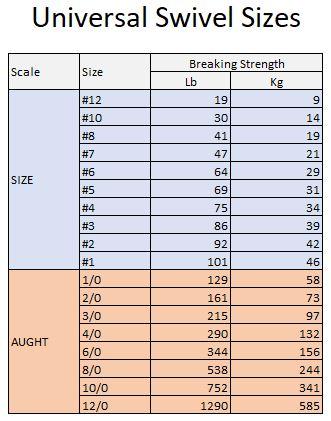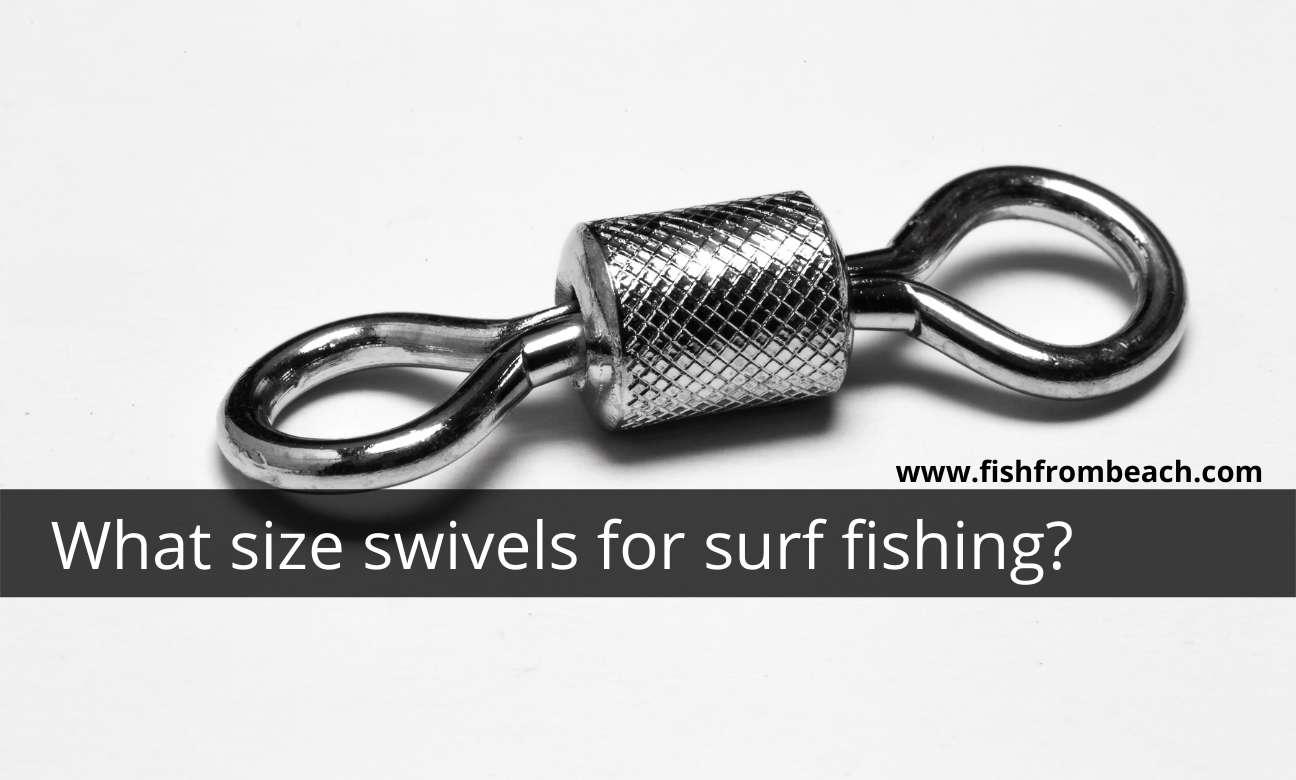Swivels are quite common in many surf fishing setups. Despite some drawbacks, they are a good solution for tying two lines together and are widely used to connect leaders and line extensions.
But like any other item in surf fishing rigs, size does matters.
Yes, the size you choose for your swivels can have an effect, althought small, on your productivity and experience.
As we will see in this article, a wrong swivel size when surf fishing increases the risk of tackle loss, snags, line twists, and can also compromise the effectiveness of some high end line setups.
So what’s the best swivel size for surf fishing? And how to choose the right swivels to meet your fishing conditions and objectives?
As a rule of thumb, the size of the swivel should match the strongest line it is attached to. For surf fishing, sizes between #1 and 2/0 work well in most situations and allow the use of powerful shock leaders without much worries.
There are more details to discuss in this subject. So if you want to know more, keep reading!
Remark. The examples and explanations I will evoke in this post will all be about ball bearing swivels. This is the type that I use the most and that I have more knowledge about. However, note that the same logic generally also applies to other types of swivels such as snap and barrel swivels.
The size swivel explained
The way we refer to a swivel size can be quite confusing. This is because there are two different scales that follow inverse measurement rules.
The first scale or what we call the “size swivel” scale is for small swivels (generally under 20mm in length). The main two things to remember about this scale are:
- The number is always preceeded by a a hash carachter “#”
- The higher the number, the smaller the swivel (This adds more confusion, I know :D)
For example, a # 10 swivel (we pronounce it size 10 swivel) is smaller than a # 5 swivel. The former is usually around 10mm in length while the latter is around 13mm)
So, in the size scale, the swivel gets bigger as we go down the scale. Once we reach size # 1, we move on to the second scale called the “aught” measurement system.
Now, with the “aught” system, all numbers are followed by “/0”, and unlike the “size” scale, the higher the number, the bigger the swivel.
This way, a 10/0 hook (We pronounce it 10 aught) is larger than a 6/0 hook. The first is around 50mm in length and the second is 37mm only.
So any swivel you got, know that it is either under the “size” or “aught” measurement system. As a rule of thumb, if it measures more than 20 mm in length, then it’s within the “aught” spectrum.
It should also be noted that the size of a swivel dictates not only its length and width, but also its breaking strength and the weight it can handle.
This is the information we need to answer our question: What size swivel for surf fishing?

What dictates the swivel size to use?
The rule here is simple. You need to match your swivel to the heaviest line it will be attached to.
What does this mean? It means that if your swivel is going to connect a 20lb test line to 15lb test leader, then the swivel needs to be able to handle at least 20lbs of weight.
Similarly, if your leader is 80lb test and your line is 30lb test, then the swivel should be able to whitstand 80 pounds of weight.
As simple as that.
The point here is to make sure that when things get tense the line or leader breaks before the swivel and not the other way around.
I know, this doesn’t reduce the break-off risk since something is going to snap anyway. But, choosing the right swivel size let you be assured that the breakage won’t come from the swivel but from the line.
This way, you can focus more on the line/leader and, as a result, make better choices that reduce the breakage risk.
Worth noting also that swivels are extremely hard to break, even if you go under your lines pound test. In most cases, it’s the knot connecting the swivel that fails first.
Ok, I understand. But how do I know how much weight a swivel can support?
As we said before, the swivel size is a also an indictaor of it’s strength and weight resistance.
The table below shows the most common swivel sizes and the approximate weight they can support. Some brands will have slightly different figures, but I believe you can still rely on this table to choose the size of your surf fishing swivels.

What size swivel for surf fishing?
Well, when surf fishing, the main line is most of the time under 60 pounds test. The terminal leader is usually thinner than that because we have to remain invisible and small in front of fish.
So it is quite safe to say that any swivel larger than size # 6 will work well for surf fishing.
Now with that said, remember that you often need a shock leader when fishing off the beach.
We have discussed shock leaders and their importance in details in another article. I encourage you to read it because it’s a very critical subject.
But to speak briefely, a shock leader is a thick line extension that you can add to the main line so that it prevent cut-offs and absorb the massive stress you create when casting weights.
Shock leaders are therefore very important because they save you a lot of tackle losses and line snaps, but more importantly, because they protect you and the others surrounding you from the heavy objects you throw.
Anyway, If you are going to use a shock leader and add a swivel to connect it to the terminal leader, then make sure the swivel can support more weight than the shock leader.
Shock leaders are typically between 80 and 100 lb test. So swivels rated between #1 and 2/0 are the safe choice for most situations.
Why don’t just go with the largest swivel available and completely remove the risk of breakage?
That’s because large swivels hurt overall performance and cause a few issues when fishing.
The main drawback of large swivels is that they are more prone to snags, especially when fishing rough grounds and rocky structures.
Also, the bigger the swivel, the more line twists and tangles it causes. This is a major time thief when fishing as you might spend an inordinate amount of time trying to free your line or renew your setups.
Another thing to keep in mind is that sizable swivels receive more pressure from the wind and water currents, which reduces the casting distance and makes the terminal tackle less stable in the surf zone.
On the other hand however, the size of your swivel should be large enough to meet the requirements of your rig.
For example, in the fish finder rig and Carolina rig, we often use a swivel as a stopper of the sliding sinker. Here, the swivel should be larger than the hole of the sinker (or the plastic sleeve used to make the sinker slide).
So for surf fishing, I suggest that you bring with you 4-5 swivels of each size from #5 up to 2/0. Start with the minimum size that matches the strongest line in the swivel poles, then gradually increase if required.
Note also that although swivels are tough to break, exposing them to corrosion, saltwater, and harsh environments (like fishing in abrasive shores), reduce their breaking strength and makes them less resistant to weights.
So make sure to change your swivels often enough and give them proper maintenance, especially after saltwater fishing.
Note (*): If you make a purchase through links from this website, we may get a small share of the sale from Amazon or other similar affiliate programs.
Surf Fishing Survey
Help us provide you with better content by answering simple questions about your surf fishing experience and knowledge.
We will put the collected responses together and turn them into valuable information that will help you catch more fish from shore 😉
Note: No personal information will be collected with your answer.

